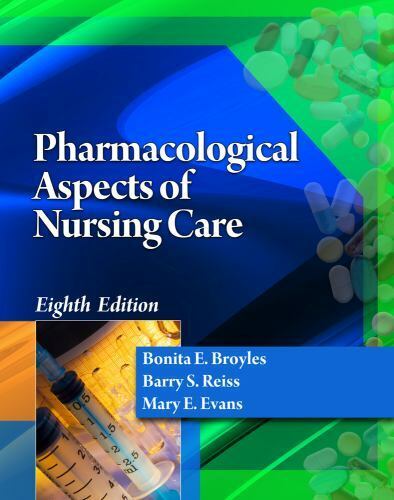Test Bank For Pharmacological Aspects of Nursing Care 8Th Ed By Broyles Reiss Evans
Digital item No Waiting Time Instant DownloadISBN-10 : 1435489209 ISBN-13 : 978-1435489202
In Stock
Original price was: $75.00.$10.00Current price is: $10.00.
Test Bank For Pharmacological Aspects of Nursing Care 8Th Ed By Broyles Reiss Evans
CHAPTER 2: PRINCIPLES AND METHODS OF DRUG ADMINISTRATION TRUE/FALSE1.An important component in medication administration is to assess the client for drug allergies. ANS:TPTS:1REF:p. 40OBJ: Cognitive Level: Application 2.The right documentation for medication administration includes documenting a client’s refusal of a medication. ANS: T PTS: 1 REF: p. 50, Safe Nursing Practice 2-10OBJ: Cognitive Level: Application 3.The deltoid site for IM injections may be used for up to 3 mL of solution. ANS: F FeedbackCorrectThe maximum amount of solution to be injected into the deltoid site is 1 mL.Incorrect PTS:1REF:p. 56, Safe Nursing Practice 2-13OBJ: Cognitive Level: Comprehension 4.For teaching to be effective, the client must indicate a readiness to learn. ANS:TPTS:1REF:p. 64OBJ: Cognitive Level: Application 5.One long teaching session is usually more effective than several short sessions. ANS: F FeedbackCorrectSeveral brief teaching periods may be more effective than one long session, because the client needs time to absorb the material covered before continuing with the next topic.Incorrect PTS: 1 REF: p. 65 OBJ: Cognitive Level: ComprehensionMULTIPLE CHOICEA second-year nursing student is preparing to administer medications to clients in a small rural hospital. The questions that follow review some of the information she will need to know in order to administer medications safely and effectively. 1.In measuring liquid medications with a dropper, it is important to hold the dropper:a.4 inches above the receptacle.c.horizontally to the receptacle.b.at a 45-degree angle to the receptacle.d.vertically to the receptacle. ANS: D FeedbackAIncorrect: This would promote splashing of the medication and inaccuracy of the dosage.BIncorrect: This will not promote accuracy.CIncorrect: This will not promote accuracy.DCorrect: This will provide the nurse with an eye-level view of the medication and amount markings on the receptacle. PTS:1REF:p. 53, Table 2-6OBJ: Cognitive Level: Application 2.The muscle(s) used in the ventrogluteal injection site is/are the:a.vastus lateralis.c.gluteus maximus.b.gluteus minimus and medius.d.deltoid. ANS: B FeedbackAIncorrect: This is the muscle in the thigh.BCorrect: The gluteus minimus and medius muscles are used for the ventrogluteal site.CIncorrect: This muscle is used for the dorsogluteal site.DIncorrect: This muscle is used for the deltoid site in the upper arm. PTS: 1 REF: p. 57 OBJ: Cognitive Level: Knowledge 3.Subcutaneous injections:a.may be given at either a 45- or a 90-degree angle except insulin and heparin are given at a 90-degree angle.b.are given with a 5/8-inch needle, although a longer needle may be used for obese persons.c.can be given in the abdomen on either side of the umbilicus.d.all of the above ANS: D FeedbackAIncorrect: Although a true statement, it is not the most complete answer.BIncorrect: Although a true statement, it is not the most complete answer.CIncorrect: Although a true statement, it is not the most complete answer.DCorrect: This incorporates all of the other answers, so it is the best answer. PTS:1REF:p. 58, Safe Nursing Practice 2-14OBJ: Cognitive Level: Comprehension4.Normally, the gluteal muscles may be used as injection sites for children after:a.three months of age.b.one year of age.c.the child has been walking for one year.d.the child has been walking for six months. ANS: C FeedbackAIncorrect: The dorsogluteal muscle should not be used until walking has been established.BIncorrect: The dorsogluteal muscle should not be used until walking has been established.CCorrect: Established walking helps develop the gluteal muscles, which helps provide adequate muscle tissue for accepting an injection.DIncorrect: This is not long enough for adequate muscle development. PTS:1REF:p. 56, Safe Nursing Practice 2-13OBJ: Cognitive Level: Comprehension 5.Which of the following abbreviations means “drop”?a.gttc.aab.O.D.d.p.o. ANS: A FeedbackACorrect: This is the approved abbreviation for drop.BIncorrect: This is the abbreviation for right eye.CIncorrect: This is the abbreviation for of each.DIncorrect: This is the abbreviation for per os, or by mouth. PTS: 1 REF: p. 42, Table 2-1 OBJ: Cognitive Level: Knowledge


Reviews
There are no reviews yet.